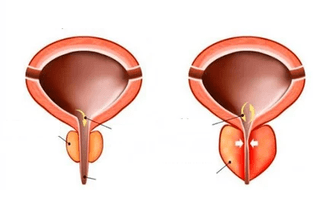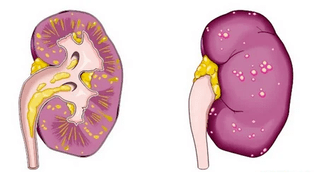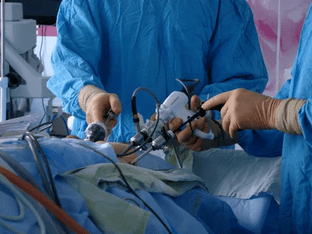
Many doctors joke that menopausal men call prostatitis. The disease is diagnosed in 20% of cases in men after forty years, in 70% - after sixty years and in 90% of cases after seventy years. The disease can occur in two forms: acute and chronic prostatitis. This disease must be treated, especially since the disease is therapeutic. But many men ignore the unpleasant symptoms, which lead to the occurrence of many complications that become more difficult to cure.
Reason for development
Acute prostatitis is an acute pathology of the prostate that develops as a result of inflammatory and infectious processes in organs due to the penetration of pathogens into tissues. The disease is characterized by the appearance of swollen glands, purulent contents in the tissues.This leads to the appearance of many unpleasant symptoms, a violation of the function of the organs of the genitourinary system.
There are many causes of acute prostatitis. In most cases, it is provoked by pathogenic microbes.A number of microbes can exist in the body of a healthy person in passive form on the skin or intestines. Under the influence of several factors, they are activated, penetrate into the glandular tissue and actively reproduce there. Often the disease appears due to STDs, for example,chlamydia, ureaplasmosis, gonorrhea, etc.
Also, acute forms of prostatitis occur as a complication ofurethritis. Germs enter through open channels into the urethra. Also, often the cause of prostatitis is the spread of bacteria from other organs of the genitourinary system. Often, glands can be affectedduring surgical procedures, catheterization, diagnostic measures.
Because the prostate gland contains a large number of blood vessels, the infection can enter here through the bloodstream with chronic pathology in the body, for example,tonsillitis, bronchitis, etc.Withanal fissure, microbes can enter the prostate with lymph flow.
But infection does not always lead to the development of disease. Congestion in the pelvic tract, which developswith prolonged abstinence from sexual intercourse or a large number of them.
Congestion is also associated withlack of physical activity, persistent constipation, alcoholism, varicose veins in the pelvic area, hypothermia.
Classification
In urology, several forms of pathology are distinguished, which are also stages of development:
- The catarrhal formis characterized by the appearance of inflammation in the organ, changes in its mucous epithelium. Over time, swelling of the glands occurs, mucopurulent secretions are collected in it, contributing to the development of the disease.
- Then the focus appears. The disease enters the second stage (form) -follicular form. The urinary tract is narrowed or clogged, the secretion stops being removed from the organ normally. Pus can be expelled into the urinary tract, forming a purulent focus there. The glandular cells change, the prostate continues to swell and enlarge.
- The parenchymal formdevelops when the organ is fully inflamed, a purulent infection develops in it. In the absence of therapy, the small purulent focus merges into one large, enlarged abscess, which often opens into the urethra, intestine and bladder. In some cases, it is possible to immediately develop this form of pathology when the infection penetrates into the interstitial tissue of an organ with blood or lymph flow.

Symptoms
Shows symptoms of acute prostatitis. How many signs will be seen and felt will depend on the form (stage) of the disease. Common symptoms include the following:
- pain syndrome during urinary excretion;
- symptoms of intoxication;
- pain in genital area;
- urges frequent use of toilets, especially at night;
- possible removal from the urethra.
As male prostatitis develops, the pain syndrome will spread to other areas. This is due to the transmission of impulses along the nerve endings. Urine excretion becomes very painful. Often at this stage, acute delay develops, which is considered a dangerous condition, as it can lead to rupture of the bladder.
Symptoms of acute prostatitis continue to increase. There is severe pain during defecation, increased body temperature. The prostate becomes enlarged, tight, and sore. Urine will be cloudy due to the content of pus and mucus.
In the last stage, the disease manifests itself strongly.
Body temperature rises very much, accompanied by fever and chills, loss of appetite, severe weakness, overall body fatigue. Urination may stop completely, and when going to the toilet, the man will experience severe excruciating pain. This condition is very painful, the pain syndrome begins to spread throughout the pelvic area. A man could not find a place for himself, he had to lie down with a tucked limb. If the inflammation has spread to the rectum, then mucus will come out of the anus. Yellow-green mucus mixed with blood is released from the urinary tract.

This condition can causesepsis, cystitis, pielonefritis, chronic prostatitis, abscess. In this case, immediate patient treatment and emergency treatment are required.
Diagnostics
Since the symptoms of acute prostatitis in men are quite pronounced, doctors may immediately suspect pathology. But he needs a thorough examination. Rectal examination in this case is strictly contraindicated.
Urologists must determine the stage (form) of the disease using laboratory and instrumental techniques. The doctor tookprostate secretfor examination. The concentration of leukocytes will increase in it, which indicates acute inflammation.
Thenblood and urine laboratory tests are performed. Urine is sent to the bacteriological culture for examination, as well as the determination of the causative agent of its infection and its sensitivity to antibacterial drugs. You can also do:
- PCR for STD detection;
- uroflowmetry to identify the severity of organ disorders; Prostate ultrasound to determine the shape and size of an organ, changes in it, stage of disease;
- dopplerometry helps distinguish acute prostatitis from other pathologies;
- Pelvic organ MRI is often prescribed when planning surgical interventions;
- analysis of SPA concentration in the blood;
- urethra removal smear examination;
- puncture of an organ part with suspected purulent infection and abscess.
Treatment
A urologist will tell you in detail how to treat acute prostatitis. The main component of therapy is antibacterial drugs, which are selected according to the results of bacterial culture. In two or three days, antibiotics begin to help, the person feels better, the pain begins to subside. But with this form of the disease, such a drug should be taken for a month, even if the symptoms have completely disappeared.
Also necessary to prevent the disease from becoming chronic, which is quite common.
When choosing a medication, the doctor takes into account another factor:
- some agents do not penetrate the glandular tissue properly;
- Other agents accumulate in tissues in large quantities.
Treatment of acute prostatitis in men should be based on the use of strong drugs, as in other life-threatening cases. Usually doctors prescribe fluoroquinolones. When using macrolides, the dose must be large. This is especially true in patients with immunosuppression.
Antibiotics are usually given by intravenous injection. In the early stages, the disease can be treated at home or on an outpatient basis.In this case, bed rest is prescribed, as any force load can provoke the spread of infection and the development of sepsis.
In combination with antibiotics, the following medications are also prescribed:
- analgesics;
- antipyretic drugs;
- NSAID;
- for severe pain, opiate medication may be prescribed;
- diuretics to reduce body poisoning;
- laxative to facilitate bowel movements;
- antispasmodic drugs to facilitate the excretion of urine;
- alpha blocker.
If a man experiences acute urinary retention, urea catheterization is performed. Antiandrogen is often used to reduce swelling and inflammation in organs, improve the outflow of secretions, normalize blood flow in the glands, and reduce the risk of infection spreading throughout the body.
Use of hormones such as estrogen, cold enema to relieve swelling and pain. Massage and thermal procedures for this form of the disease are strictly prohibited. They can only be used during the recovery period.
Surgery

If there is no pain, the doctor may suspect the development of an abscess. In this case, surgical intervention is performed to remove the area where it occurred. Abscess puncture drainage is often used. In severe and extreme cases, the organ is removed.
This operation is prescribed for abscesses, acute urinary retention, severe pain syndrome that can not be eliminated by any medication, the appearance of stones and neoplasms, as well as ineffective drug treatment, frequent infections of the genitourinary system, paraproctitis.
Surgeons can use one of the following techniques:
- TRUP (transurethral resection)involves the removal of internal organs. Often used;
- Prostatectomyinvolves the removal of part or all of an organ through an incision in the lower abdomen;
- Laser surgery. In this case, the affected area of the organ is removed using a laser;
- The abscess is driedthrough the rectum. Drainage is inserted into the incision, where the pus is pumped out;
- To facilitate urinary excretion,transurethral incisionis performed on the organ.
When the structure of glandular tissue is restored, its function is normalized, the secretion of the prostate normalizes its composition, the pathological causative agent is completely eliminated from the body, we can discuss the cure of prostatitis.
Forecast
With therapy, the prognosis of the disease will be good. Sometimes the negative consequences of acute prostatitis develop. The disease can be chronic, so it will be harder to get rid of. The dangerous consequences of untreated disease are organ abscess, sepsis, acute urinary retention. In some cases, due to the emergence of complications, death can occur. But usually men do not let such consequences develop, because they come to the doctor and start therapy.
Prevention

For preventive purposes, it is necessary to prevent the emergence of predisposing factors. This requires timely treatment for all infections in the body so that it does not become chronic and does not become the focus of infection that has the potential to spread to the prostate gland.
During the surgical procedure, the doctor should pay attention to the use of antiseptics. Otherwise, the risk of germs entering the patient's body increases. It is important that a man and his sexual partner treat STDs on time, and it is best to prevent them. Sex life should happen with a normal partner, it should be fixed.
You need to lead an active lifestyle, play sports or exercise, adhere to the rules of intimate hygiene.
Men usually seek medical advice in an emergency. But when negative signs appear, it is best to contact them immediately. This will help prevent many health problems and even, in some cases, save lives.
























